Modern dance
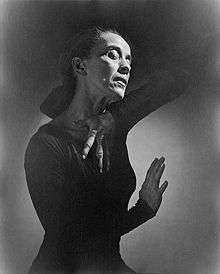
Modern dance is a broad genre of western concert or theatrical dance (as opposed to participation dance), primarily arising out of Germany and the United States in the late 19th and early 20th centuries.
The oversimplification of modern dance's history often leads to the erroneous explanation that the art form emerged merely as a rejection of, or rebellion against classical ballet. An in-depth analysis of the context of the emergence of modern dance reveals that as early as the 1880s, a range of socioeconomic changes in both the United States and Europe was initiating tremendous shifts in the dance world.
In America, increasing industrialization, the rise of a middle class (which had more disposable income and free time), and the decline of Victorian social strictures led to, among other changes, a new interest in health and physical fitness.[1] "It was in this atmosphere that a 'new dance' was emerging as much from a rejection of social structures as from a dissatisfaction with ballet."[2] During that same period, "the champions of physical education helped to prepare the way for modern dance, and gymnastic exercises served as technical starting points for young women who longed to dance"[3]—and women's colleges were already offering "aesthetic dance" courses by the end of the 1880s[4]
Concurrently, dance artists such as Isadora Duncan, Maud Allen, and Loie Fuller were pioneering new forms and practices in what is now called aesthetic or free dance for performance. These dancers disregarded ballet's strict movement vocabulary, the particular, limited set of movements that were considered proper to ballet, and stopped wearing corsets and pointe shoes in the search for greater freedom of movement. Emil Rath, who wrote at length about this emerging artform at the time stated,
"Music and rhythmic bodily movement are twin sisters of art, as they have come into existence simultaneously...today we see in the artistic work of Isadora Duncan, Maud Allen, and others the use of a form of dancing which strives to portray in movements what the music master expresses in his compositions—interpretative dancing."[5]
American modern dance can be divided (roughly) into three periods or eras:[6]
| Dates | Era | Examples of Artists | Notes |
|---|---|---|---|
| 1880-1923 | Early Modern Period | Isadora Duncan, Loie Fuller, Ruth St. Denis, Ted Shawn, Eleanor Anderson | New Dance, Free Dance, and Modern Romanticism could be other names for this period. While artistic practice changed tremendously during this period, clearly distinct modern dance techniques had not yet emerged. |
| 1923-1946 | Central Modern Period | Martha Graham, Doris Humphrey, Katherine Dunham, Charles Weidman, Lester Horton | Many dance artists during this era searched for an American way of moving, and created an American artform. They also developed clearly defined and recognizable dance training systems. |
| 1946-1957 | Late Modern Period | José Limón, Pearl Primus, Merce Cunningham, Talley Beatty, Erick Hawkins, Anna Sokolow, Anna Halprin, Paul Taylor | This period brought clarity of abstractionism, the rise of the avant-garde, and paved the way for postmodernist dance. |
From roughly 1914 forward, sociopolitical concerns added fuel to the continued development of modernist dance in the United States and Germany. The First and Second World Wars, the rise of fascism, the Great Depression (in the US), and the evolution of other artforms each informed modern dance along the way. Moving into the 1960s, new ideas about dance began to emerge, again in large part as a response to both earlier dance forms as much as to social changes. Eventually, postmodern dance artists would reject the formalism of modern dance, and include elements such as performance art, contact improvisation, release-technique, and improvisation.[7]
The discussion that follows is by no means an exhaustive list of modern dance artists in either the United States or Germany. As will become clear below, modern dance has evolved with each subsequent generation of participating artists. Artistic content has morphed and shifted from one choreographer to another, and so too have styles and techniques. Artists such as Martha Graham and Lester Horton developed techniques in the Central Modern Period that are still taught worldwide, and numerous other types of modern dance exist today—many of which are associated with renowned schools and master teachers.
Free dance
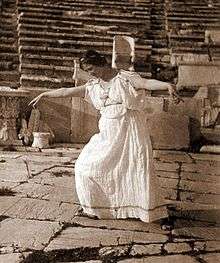
- 1877: Isadora Duncan was a predecessor of modern dance with her stress on the center or torso, bare feet, loose hair, free-flowing costumes, and incorporation of humor into emotional expression. She was inspired by classical Greek arts, folk dances, social dances, nature, natural forces, and new American athleticism such as skipping, running, jumping, leaping, and abrupt movements. She thought that ballet was ugly and meaningless gymnastics. Although she returned to the United States at various points in her life, her work was not very well received there. She returned to Europe and died in Paris in 1927.
- 1891: Loie Fuller (a burlesque skirt dancer) began experimenting with the effect that gas lighting had on her silk costumes. Fuller developed a form of natural movement and improvisation techniques that were used in conjunction with her revolutionary lighting equipment and translucent silk costumes. She patented her apparatus and methods of stage lighting that included the use of coloured gels and burning chemicals for luminescence, and also patented her voluminous silk stage costumes.
- 1905: Ruth St. Denis, influenced by the actress Sarah Bernhardt and Japanese dancer Sada Yacco, developed her translations of Indian culture and mythology. Her performances quickly became popular and she toured extensively while researching Oriental culture and arts.
Expressionist and early modern dance in Europe
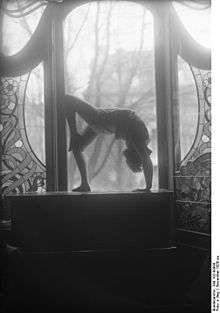
In Europe, Mary Wigman, Francois Delsarte, Émile Jaques-Dalcroze (Eurhythmics), and Rudolf Laban developed theories of human movement and expression, and methods of instruction that led to the development of European modern and Expressionist dance. Other pioneers included Kurt Jooss (Ausdruckstanz) and Harald Kreutzberg.
Radical dance
Disturbed by the Great Depression and the rising threat of fascism in Europe, the radical dancers tried to raise consciousness by dramatizing the economic, social, ethnic and political crises of their time.
- Hanya Holm, a student of Mary Wigman and instructor at the Wigman School in Dresden, founded the New York Wigman School of Dance in 1931 (which became the Hanya Holm Studio in 1936) introducing Wigman technique, Laban's theories of spatial dynamics, and later her own dance techniques to American modern dance. An accomplished choreographer, she was a founding artist of the first American Dance Festival in Bennington (1934). Holm's dance work Metropolitan Daily was the first modern dance composition to be televised on NBC and her labanotation score for Kiss Me, Kate (1948) was the first choreography to be copyrighted in the United States. Holm choreographed extensively in the fields of concert dance and musical theater.[8]
- Anna Sokolow—A student of Martha Graham and Louis Horst, Sokolow created her own dance company (circa 1930). Presenting dramatic contemporary imagery, Sokolow's compositions were generally abstract, often revealing the full spectrum of human experience reflecting the tension and alienation of the time and the truth of human movement.
- José Limón—In 1946, after studying and performing with Doris Humphrey and Charles Weidman, Limón established his own company with Humphrey as artistic director. It was under her mentorship that Limón created his signature dance The Moor’s Pavane (1949). Limón’s choreographic works and technique remain a strong influence on contemporary dance practice.[9]
- Merce Cunningham—A former ballet student and performer with Martha Graham, he presented his first New York solo concert with John Cage in 1944. Influenced by Cage and embracing modernist ideology using postmodern processes, Cunningham introduced chance procedures and pure movement to choreography and Cunningham technique to the cannon of 20th-century dance techniques. Cunningham set the seeds for postmodern dance with his non-linear, non-climactic, non-psychological abstract work. In these works each element is in and of itself expressive, and the observer (in large part) determines what it communicates.
- Erick Hawkins—A student of George Balanchine, Hawkins became a soloist and the first male dancer in Martha Graham's dance company. In 1951, Hawkins, interested in the new field of kinesiology, opened his own school and developed his own technique (Hawkins technique) a forerunner of most somatic dance techniques.
- Paul Taylor—A student of the Juilliard School of Music and the Connecticut College School of Dance. In 1952 his performance at the American Dance Festival attracted the attention of several major choreographers. Performing in the companies of Merce Cunningham, Martha Graham, and George Balanchine (in that order), he founded the Paul Taylor Dance Company in 1954. The use of everyday gestures and modernist ideology is characteristic of his choreography. Former members of the Paul Taylor Dance Company included Twyla Tharp, Laura Dean, Dan Wagoner, and Senta Driver.
- Alwin Nikolais—A student of Hanya Holm. Nikolais's use of multimedia in works such as Masks, Props, and Mobiles (1953), Totem (1960), and Count Down (1979) was unmatched by other choreographers. Often presenting his dancers in constrictive spaces and costumes with complicated sound and sets, he focused their attention on the physical tasks of overcoming obstacles he placed in their way. Nikolais viewed the dancer not as an artist of self-expression, but as a talent who could investigate the properties of physical space and movement.
Early modern dance in America
In 1915, Ruth St. Denis founded the Denishawn school and dance company with her husband Ted Shawn.[10] St. Denis was responsible for most of the creative work, and Shawn was responsible for teaching technique and composition. Martha Graham, Doris Humphrey, and Charles Weidman were all pupils at the school and members of the dance company. Seeking a wider and more accepting audience for their work, Duncan, Fuller, and Ruth St. Denis all toured Europe. Fuller's work also received little support outside Europe. St. Denis returned to the United States to continue her work.
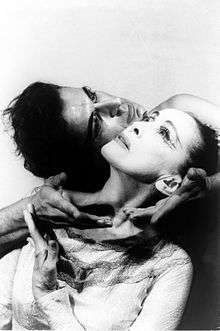
Martha Graham is often regarded as the founding mother of modern 20th-century concert dance.[11] Graham viewed ballet as too one-sided: European, imperialistic, and un-American.[12] She became a student at the Denishawn school in 1916 and then moved to New York City in 1923, where she performed in musical comedies, music halls, and worked on her own choreography.[13] Graham developed her own dance technique, Graham technique, that hinged on concepts of contraction and release.[11] In Graham's teachings, she wanted her students to "Feel". To "Feel", means having a heightened sense of awareness of being grounded to the floor while, at the same time, feeling the energy throughout your entire body, extending it to the audience.[14] Her principal contributions to dance are the focus of the ‘center’ of the body (as contrast to ballet's emphasis on limbs), coordination between breathing and movement, and a dancer’s relationship with the floor.[13]
- 1923: Graham leaves Denishawn to work as a solo artist in the Greenwich Village Follies.
- 1928: Humphrey and Weidman leave Denishawn to set up their own school and company (Humphrey-Weidman).
- 1933: Shawn founds his all male dance group Ted Shawn and His Men Dancers based at his Jacob's Pillow farm in Becket, Massachusetts.
After shedding the techniques and compositional methods of their teachers the early modern dancers developed their own methods and ideologies and dance techniques that became the foundation for modern dance practice:
- Martha Graham and Louis Horst
- Doris Humphrey and Charles Weidman
- Helen Tamiris—originally trained in free movement (Irene Lewisohn) and ballet (Michel Fokine) Tamiris studied briefly with Isadora Duncan but disliked her emphasis on personal expression and lyrical movement. Tamiris believed that each dance must create its own expressive means and as such did not develop an individual style or technique. As a choreographer Tamiris made works based on American themes working in both concert dance and musical theatre.
- Lester Horton—choosing to work in California (3000 miles away from New York, the center of modern dance), Horton developed his own approach that incorporated diverse elements including Native American dances and modern jazz. Horton's dance technique (Lester Horton Technique) emphasises a whole-body approach including flexibility, strength, coordination, and body awareness to allow freedom of expression.
Popularization in America
In 1927, newspapers regularly began assigning dance critics, such as Walter Terry, and Edwin Denby, who approached performances from the viewpoint of a movement specialist rather than as a reviewer of music or drama. Educators accepted modern dance into college and university curricula, first as a part of physical education, then as performing art. Many college teachers were trained at the Bennington Summer School of the Dance, which was established at Bennington College in 1934.
Of the Bennington program, Agnes de Mille wrote, "...there was a fine commingling of all kinds of artists, musicians, and designers, and secondly, because all those responsible for booking the college concert series across the continent were assembled there. ... free from the limiting strictures of the three big monopolistic managements, who pressed for preference of their European clients. As a consequence, for the first time American dancers were hired to tour America nationwide, and this marked the beginning of their solvency." (de Mille, 1991, p. 20
Today, modern dance continues to be popular across the world. Ballet companies have begun incorporating modern dance not only into their class repertoire, but their performances as well. Modern dance is one of the only art forms that allow free expression and that is why it remains so well loved by many. The ability to free yourself while you dance is a quality that not many forms of dance poses. With modern dance, there are no boundaries; you simply dance through your feelings, which creates an extraordinary art form.
African American modern dance
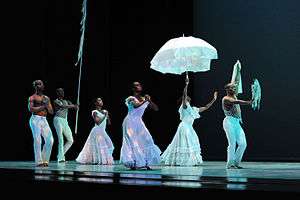
The development of modern dance embraced the contributions of African American dance artists regardless of whether they made pure modern dance works or blended modern dance with African and Caribbean influences.
- Katherine Dunham—An African American dancer, and anthropologist. Originally a ballet dancer, she founded her first company Ballet Negre in 1936 and later the Katherine Dunham Dance Company based in Chicago, Illinois. In 1945, Dunham opened a school in New York where she taught Katherine Dunham Technique, a blend of African and Caribbean movement (flexible torso and spine, articulated pelvis, isolation of the limbs, and polyrhythmic movement) integrated with techniques of ballet and modern dance.
- Pearl Primus—A dancer, choreographer, and anthropologist, Primus drew on African and Caribbean dances to create strong dramatic works characterized by large leaps in the air. Primus often based her dances on the work of black writers and on racial and African-American issues. Primus created works based on Langston Hughes The Negro Speaks of Rivers (1944), and Lewis Allan's Strange Fruit (1945). Her dance company developed into the Pearl Primus Dance Language Institute which teaches her method of blending African-American, Caribbean, and African influences with modern dance and ballet techniques.
- Alvin Ailey—A student of Lester Horton, Bella Lewitzky, and later Martha Graham, Ailey spent several years working in both concert and theater dance. In 1958, Ailey and a group of young African-American dancers performed as the Alvin Ailey American Dance Theater in New York. Ailey drew upon his blood memories of Texas, the blues, spirituals and gospel as inspiration. His most popular and critically acclaimed work is Revelations (1960).
Legacy of modern dance
The legacy of modern dance can be seen in lineage of 20th-century concert dance forms. Although often producing divergent dance forms, many seminal dance artists share a common heritage that can be traced back to free dance.
Postmodern dance
Postmodern dance developed in the 1960s in United States when society questioned truths and ideologies in politics and art. This period was marked by social and cultural experimentation in the arts. Choreographers no longer created specific 'schools' or 'styles'. The influences from different periods of dance became more vague and fragmented.[11] It is very common for postmodern dance to be performed to little or no music at all.
Contemporary dance
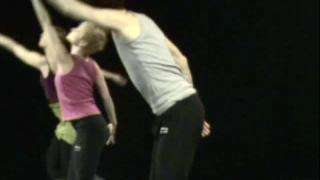
Contemporary dance emerged in the 1950s as the dance form that is combining the modern dance elements and the classical ballet elements.[15] It can use elements from non-Western dance cultures, such as African dancing with bent knees as a characteristic trait, and Butoh, Japanese contemporary dancing that developed in the 1950s.[11][16] It is also derived from modern European themes like poetic and everyday elements, broken lines, nonlinear movements, and repetition. Many contemporary dancers are trained daily in classical ballet to keep up with the technicality of the choreography given. These dancers tend to follow ideas of efficient bodily movement, taking up space, and attention to detail. Contemporary dance today includes both concert and commercial dance because of the lines being blurred by pop culture and television shows. According to Treva Bedinghaus,"Modern dancers use dancing to express their innermost emotions, often to get closer to their inner-selves. Before attempting to choreograph a routine, the modern dancer decides which emotions to try to convey to the audience. Many modern dancers choose a subject near and dear to their hearts, such as a lost love or a personal failure. The dancer will choose music that relates to the story they wish to tell, or choose to use no music at all, and then choose a costume to reflect their chosen emotions."[17]
Modern Dance can also be a medium of healing, many physical therapy organizations have dance as a part of the therapy process. Any interpretive dance is known to be helpful to the mind, soul, and body. Studies done around the world show that dance and physical exercise help improve our wellbeing.
Teachers and their students
This list illustrates the basic teacher / student links in modern dance.

- Ted Shawn—Shawn Fundamentals
- Denishawn (school and company)
- Doris Humphrey and Charles Weidman—The Art of Making Dances (Humphrey)
- Humphrey-Weidman school—Humphrey-Weidman technique (fall and recovery)
- José Limón—Limón technique
- Humphrey-Weidman school—Humphrey-Weidman technique (fall and recovery)
- Martha Graham—Graham technique (and Louis Horst)
- Erick Hawkins (via George Balanchine)—Hawkins technique
- Anna Sokolow
- May O'Donnell
- Merce Cunningham—Cunningham technique (also see Postmodern dance)
- Paul Taylor
- Trisha Brown
- Doris Humphrey and Charles Weidman—The Art of Making Dances (Humphrey)
- Lester Horton—"Horton Technique"
- Rudolf von Laban
- Émile Jaques-Dalcroze
- Katherine Dunham—Katherine Dunham Technique
- Pearl Primus
- Helen Tamiris
See also
- 20th century concert dance
- Corporeal mime—Étienne Decroux technique
- List of dance style categories
- Types of Modern Dance
- Women in dance
References
- ↑ Kurth, P. (2001). Isadora: A sensational life. Boston: Little, Brown & Co. pp. 28–29.
- ↑ Legg, Joshua (2011). Introduction to Modern Dance Techniques. Hightstown, NJ: Princeton Book Company. p. 1. ISBN 978-0-87127-3253.
- ↑ Anderson, Jack (1997). Art Without Boundaries: The world of modern dance. Iowa City: University of Iowa Press. p. 8.
- ↑ McPherson, Elizabeth (2008). The Contributions of Martha Hill to American Dance and Dance Education, 1900-1995. Lewisto n: The Edwin Mellen Press. p. 5.
- ↑ Rath, Emil (1914). Aesthetic Dancing. New York: A. S. Barnes Company. p. v-vi.
- ↑ Legg, Joshua (2011). Introduction to Modern Dance Techniques. Hightstown, NJ: Princeton Book Company. p. xviii. ISBN 978-0-87127-3253.
- ↑ Scheff, Helene; Marty Sprague; Susan McGreevy-Nichols (2010). Exploring dance forms and styles: a guide to concert, world, social, and historical dance. Human Kinetics. p. 87. ISBN 0-7360-8023-6.
- ↑ Ware, Susan. "Notable American Women". Harvard University Press, 2004, p. 305-306.
- ↑ Siegel, Marcia B. "The Shapes of Change: Images of American Dance". University of California Press, 1979, p. 168-169.
- ↑ Cullen, Frank. "Vaudeville: Old & New". Psychology Press, 2007, p. 449.
- 1 2 3 4 "Origins of Contemporary Dance". Retrieved 28 February 2012.
- ↑ "Modern Dance Pioneers". Retrieved 28 February 2012.
- 1 2 "Modern Dance History". Retrieved 28 February 2012.
- ↑ Bird's Eye View: Dancing with Martha Graham and on Broadway/Dorothy Bird and Joyce Greenberg; with an introduction by Marcia B. Siegel, 1997
- ↑ "Difference Between Modern and Contemporary Dance". Retrieved 18 March 2012.
- ↑ "Contemporary Dance History". Retrieved 28 February 2012.
- ↑ "What Is Modern Dance?". Retrieved 20 November 2013.
Sources
- Dunning, Jennifer (1991-03-02). "Eleanor King, a modern dancer and choreographer, dies at 85". New York Times.
- Dunning, Jennifer (1989-03-11). "Review/Dance; Recalling the Spirit of Doris Humphrey". The New York Times.
Further reading
| Wikimedia Commons has media related to Modern dance. |
- Adshead-Lansdale, J. (Ed) (1994) Dance History: An Introduction. Routledge. ISBN 0-415-09030-X
- Anderson, J. (1992) Ballet & Modern Dance: A Concise History. Independent Publishers Group. ISBN 0-87127-172-9
- Au, S. (2002) Ballet and Modern Dance (World of Art). Thames & Hudson. ISBN 0-500-20352-0
- Brown, J. Woodford, C, H. and Mindlin, N. (Eds) (1998) (The Vision of Modern Dance: In the Words of Its Creators). Independent Publishers Group. ISBN 0-87127-205-9
- Cheney, G. (1989) Basic Concepts in Modern Dance: A Creative Approach. Independent Publishers Group. ISBN 0-916622-76-2
- Daly, A. (2002) Done into Dance: Isadora Duncan in America. Wesleyan Univ Press. ISBN 0-8195-6560-1
- de Mille, A. (1991) Martha : The Life and Work of Martha Graham. Random House. ISBN 0-394-55643-7
- Duncan, I. (1937) The technique of Isadora Duncan. Dance Horizons. ISBN 0-87127-028-5
- Foulkes, J, L. (2002) Modern Bodies: Dance and American Modernism from Martha Graham to Alvin Ailey. The University of North Carolina Press. ISBN 0-8078-5367-4
- Graham, M. (1973) The Notebooks of Martha Graham. Harcourt. ISBN 0-15-167265-2
- Graham, M. (1992) Martha Graham: Blood Memory: An Autobiography. Pan Macmillan. ISBN 0-333-57441-9
- Hawkins, E. and Celichowska, R. (2000) The Erick Hawkins Modern Dance Technique. Independent Publishers Group. ISBN 0-87127-213-X
- Hodgson, M. (1976) Quintet: Five American Dance Companies. William Morrow and Company. ISBN 0-688-08095-2
- Horosko, M (Ed) (2002) Martha Graham: The Evolution of Her Dance Theory and Training. University Press of Florida. ISBN 0-8130-2473-0
- Humphrey, D. and Pollack, B. (Ed) (1991) The Art of Making Dances Princeton Book Co. ISBN 0-87127-158-3
- Hutchinson Guest, A. (1998) Shawn's Fundamentals of Dance (Language of Dance). Routledge. ISBN 2-88124-219-7
- Kriegsman, S, A.(1981) Modern Dance in America: the Bennington Years. G K Hall. ISBN 0-8161-8528-X
- Lewis, D, D. (1999) The Illustrated Dance Technique of Jose Limon. Princeton Book Co. ISBN 0-87127-209-1
- Long, R. A. (1995) The Black Tradition in Modern Dance. Smithmark Publishers. ISBN 0-8317-0763-1
- Love, P. (1997) Modern Dance Terminology: The ABC's of Modern Dance as Defined by its Originators. Independent Publishers Group. ISBN 0-87127-206-7
- McDonagh, D. (1976) The Complete Guide to Modern Dance Doubleday. ISBN 978-0-385-05055-5
- McDonagh, D. (1990) The Rise and Fall of Modern Dance. Chicago Review Press. ISBN 1-55652-089-1
- Mazo, J, H. (2000) Prime Movers: The Makers of Modern Dance in America. Independent Publishers Group. ISBN 0-87127-211-3
- Minton, S. (1984) Modern Dance: Body & Mind. Morton Publishing Company. ISBN 978-0-89582-102-7
- Roseman, J, L. (2004) Dance Was Her Religion: The Spiritual Choreography of Isadora Duncan, Ruth St. Denis and Martha Graham. Hohm Press. ISBN 1-890772-38-0
- Shelton, Suzanne. Divine Dancer: A Biography of Ruth St. Denis. New York: Doubleday, 1981.
- Sherman, J. (1983) Denishawn: The Enduring Influence. Twayne. ISBN 0-8057-9602-9
- Terry, W. (1976) Ted Shawn, father of American dance : a biography. Dial Press. ISBN 0-8037-8557-7
|